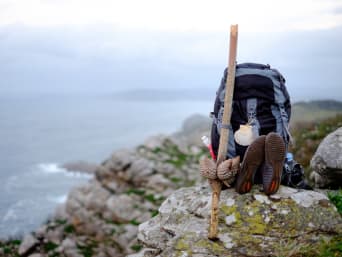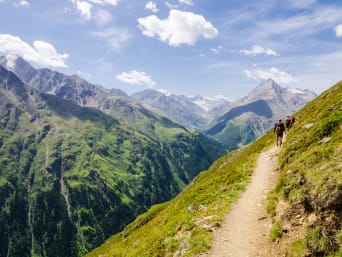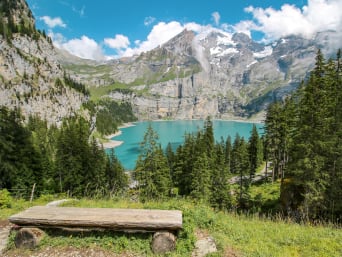The best hikes in Europe: popular hiking trails in Europe
Long-distance hiking allows you to leave your everyday life behind for several days or even weeks and become one with nature. Europe has lots of breathtaking landscapes, which are perfect for a walking holiday. To give you some inspiration for your next walking holiday, we will show you three of the most popular hiking trails in Europe and just what makes them so special. We will also look at the different levels of difficulty and routes so that you can find the trail.
The St. James Way: the dream of many long-distance walkers
The classic and probably the best-known of the European long-distance trails is the way of St. James or Camino de Santiago. The "Way of St. James’’ refers to only one particular route in the large network of the Camino de Santiago: the Camino Francés. Since the eleventh century, this has been one of the three most important Christian pilgrimage routes in the world. It leads from Saint-Jean-de-Port in France to the Spanish city of Santiago de Compostela, to the tomb of the Apostle James. In honour of the apostle, these pilgrimage routes are therefore called the Way of St. James. If you walk one of the Camino de Santiago pilgrimages, you will not only discover the beautiful Spanish landscapes, but you will also have the chance to make meet new people and get to know yourself better.

The sign of the Way of St. James is the scallop shell. It is the subject of many legends associated with St. James. If you are on the Camino, you can hang a scallop shell on your backpack to indicate that you are on a pilgrimage.
Which route on the Way of St. James should you take?
Whether you want to walk along the exciting Atlantic coast, scramble through impressive mountain landscapes or stroll along ancient Roman paths it is all possible on the vast network of paths of the Way of St. James.
Below we will show you the five most popular routes on the Way of St. James and give you an idea of their difficulty:
1. Camino Francés - the classic Way of St. James
The classic Way of St. James is the most popular pilgrimage route. It takes you across the Pyrenees via Pamplona, Burgos, and León to Santiago de Compostela. Because of its popularity, it has a good network of hostels, cafés, and restaurants, so you are always well looked after during your long-distance hike. Especially in summer, many hikers set out to walk the Way of St. James. Therefore, you should plan your walking holiday in advance.
Distance covered: approx. 800 km
Level of difficulty: easy to medium
Best season: spring & autumn
Recommendation: suitable for long-distance hikers, but can be busy during the high season

If you want to calculate the time you need to walk a long-distance trail, you can use the following method: experienced long-distance hikers cover 25 to 30 kilometres a day. Long-distance hikers who are just starting out should expect to be able to walk around 20 kilometres a day.
2. Caminho Português – the Way of St. James in Portugal
As the name suggests, this route takes you from Portugal to Santiago de Compostela. You start in Porto and walk along the wonderful Portuguese sandy beaches to Spain. You can relax and recharge your batteries at short stops in beach bars. In contrast to the Camino Francés, this pilgrimage route is much shorter and can therefore be completed in a two-week holiday.
Distance covered: approx. 250 km
Level of difficulty: easy
Best time of year: spring, summer & autumn
Recommendation: ideal for beginners
3. Camino del Norte – along the Spanish coast
The Camino del Norte runs along the Spanish Atlantic coast and is therefore often called the Coastal Way. On this pilgrimage path you can always enjoy impressive views of the Atlantic and the cool sea breeze. Therefore, this path is also well suited for the summer months. You can also go along another route which takes you inland, where you can walk through forests, meadows and mountains.
Distance covered: approx. 850 km
Level of difficulty: medium
Best season: spring, summer & autumn
Recommendation: suitable for long-distance walkers with some experience
4. Camino Primitivo – the challenging Way of St. James
If you are looking for an adventure and like mountainous landscapes, you should walk the Camino Primitivo. Although this Camino is quite short compared to the others, you will cover a lot of metres in altitude and can really work up a sweat. At the summits, you will be rewarded with breathtaking views over Spain. Due to its difficulty, this pilgrimage route is not so crowded, so you can enjoy the peace and quiet of nature.
Distance covered: approx. 300 km
Level of difficulty: difficult
Best season: spring, summer & autumn
Recommendation: suitable for long-distance walkers who are very fit and have experience with walking on mountainous terrain
5. Via de la Plata –through the whole of Spain
On this pilgrimage route, picturesque landscapes meet the fascinating history of Spain. During the hike you partly walk on old Roman paths from southern Seville through the landscapes of Andalusia and Extremadura to Santiago de Compostela. The best time to walk this longest of all Camino de Santiago routes is in spring. Along the way, you can enjoy the spring scenery in Spain.
Distance covered: approx. 1,000 km
Level of difficulty: difficult
Best season: spring, autumn & winter
Recommendation: suitable for experienced long-distance walkers in good health

The network of paths on the Way of St. James stretches across the whole of Europe. This gives you the opportunity to start your pilgrimage on the Way of St. James directly from your doorstep. You can find suitable routes at: https://www.pilgrim.es/en/routes/
E5 hike: a wonderful hike in the Alps
To cross the Alps once is a dream of many long-distance hikers. Although the European long-distance trail E5 runs from the French Atlantic coast to Venice, the most popular section of the trail is the crossing of the Alps. It is the highlight of the E5 hiking trail. The crossing of the Alps takes you from Germany via Austria to Italy.
You will be spoilt for choice on this route, as there is so much to see such as breathtaking mountain landscapes and idyllic valleys. If you have already gained experience in hiking and perhaps have already completed a few mountain hikes, you can venture on the E5 hiking trail. It requires a good level of fitness, as you will be climbing several thousand metres in altitude but it does not require any special hiking gear. The paths are well marked, and difficult sections are secured with ropes, so that even ambitious long-distance hiking beginners can master this Alpine crossing.
The route stretches through the following countries: France, Switzerland, Germany, Austria, Italy
Countries crossed on the E5 Alpine crossing: Germany, Austria, Switzerland
Distance covered: approx. 3,200 km (Alpine crossing approx. 120 km)
Level of difficulty: easy to medium, depending on the different sections
Best season: June to September
Recommendation: suitable for fit and ambitious long-distance hikers
The Via Alpina: hiking through 8 countries in the Alps
Crossing eight countries in one long-distance hike, the Via Alpina offers you this unique experience. Depending on the route you choose, you can explore up to 5,000 kilometres of Italy, Slovenia, Austria, Germany, Liechtenstein, Switzerland, France, and Monaco. You can enjoy the varied Alpine landscapes, while getting to know the cultures of the different countries.
The best time of year to go hiking is from June to October. The paths won’t have any snow and they will be easily passable. You don't need any climbing experience or special hiking gear for the Via Alpina, but you should be in good shape for the mountainous sections and have steady footing and no fear of heights.

The Via Alpina is a project that not only wants to draw attention to the beauty of the Alps, but also focuses on the protection of the countryside and wildlife. Therefore, make sure you respect any laws regarding outside spaces and don’t drop any litter.
The different routes of the Via Alpina
The Via Alpina is divided into five different routes that take you through different countries. The routes are marked by different colours. In general, most sections of the Via Alpina are easily passable and do not pose any technical challenges. However, due to the length of the Alpine hikes, you should be in good shape.
Below we will show you all five possible alpine hikes of the Via Alpina:
1. The Red Trail - the 8-country tour
The Red Trail is the classic and longest route that takes you through all the Alpine countries. It starts in Trieste in Italy and ends in Monaco. On this long-distance hiking trail, you will go up the main Alpine ridge several times, enjoy spectacular views and always find wonderful, picturesque Alpine valleys. Due to its length, this tour in its entirety is only suitable for experienced long-distance hikers. However, if you want to get started with long-distance hiking, you can also walk only a few sections of this long-distance trail and test your limits.
Countries crossed: Italy, Slovenia, Austria, Germany, Liechtenstein, Switzerland, France, Monaco
Distance covered: approx. 2,600 km
2. The Purple Trail - tour through the Limestone Alps
On the purple trail of the Via Alpina you will explore the eastern Limestone Alps. From the Karawanken to the Allgäu, this varied long-distance hiking trail takes you through Slovenia, Austria, and Germany. There is always something to discover, such as Admont Abbey, which has the largest monastic library in the world or Ludwig II's royal castles. If you’re interested in history and architecture, this is the ideal route for you.
Countries crossed: Slovenia, Austria, Germany
Distance covered: approx. 1,500 km
3. The Yellow Trail - the trail of contrasts
The yellow hiking trail of the Via Alpina is a real highlight among the Alpine hikes. It runs from the Adriatic coast to the Allgäu region and offers cultural and scenic highlights. On the way, you can visit the city of Bolzano with its famous archaeological museum, where "Ötzi - the Iceman" is exhibited. Then follow the yellow trail through the Ötztal valley to the idyllic pastures of the Allgäu.
Countries crossed: Italy, Austria, Germany
Distance covered: approx. 800 km
4. The Green Trail - the short route through the Alps
In just 13 stages, you explore Liechtenstein and Switzerland on this long-distance hiking trail. You start in the Rätikon and finally arrive in the picturesque Bernese Alps. You will cross a total of five Swiss cantons, where you can learn more about Switzerland and Swiss culture. In the Bernese Oberland, a unique view awaits you as you run along the peaks of the Eiger, Mönch and Jungfrau.
Countries crossed: Liechtenstein, Switzerland
Distance covered: approx. 300 km
5.The Blue Trail - the idyllic path
You can discover Idyllic pasture landscapes and national parks along the blue trail of the Via Alpina. On this Alpine hike you walk from the glaciers of the Monte Rosa massif to the French Mercantour National Park. You will pass through Switzerland, Italy and end your hike in France. The route is lined with quiet Alpine villages and beautiful lush green landscapes, but you will also get the chance to really enjoy the mountain scenery in the Piedmontese Alps.
Countries crossed: Switzerland, Italy, and France
Distance travelled: approx. 900 km
Conclusion: hiking trails in Europe to suit all abilities
Europe offers long-distance hikers contrasting and beautiful landscapes that you can discover on foot along well-maintained and signposted paths. It doesn't matter whether you are drawn to the Alps or want to go on a pilgrimage along the Way of St James. Every country offers unique hiking trails that are just waiting to be explored. With the right preparation and hiking gear, you will be ready to embark on your next hiking adventure!
______________________________________________
References and further information
https://www.caminodesantiago.gal/en/make-plans/the-ways
(Last accessed on 24.04.2024)
https://followthecamino.com/en/camino-de-santiago-routes/
(Last accessed on 24.04.2024)
https://www.tyrol.com/things-to-do/sports/hiking/hiking-tours/a-weitwanderweg-e5
(Last accessed on 24.04.2024)
http://www.via-alpina.org/
(Last accessed on 24.04.2024)
The image sources in this text are in chronological order
Cover photo: iStock.com/AscentXmedia
1. Image in text: iStock.com/focalmatter
2. Image in text: iStock.com/Stanislava Karagyozova
3. Image in text: iStock.com/Sabine Hortebusch
4. Image in text: iStock.com/David P. Hilss








